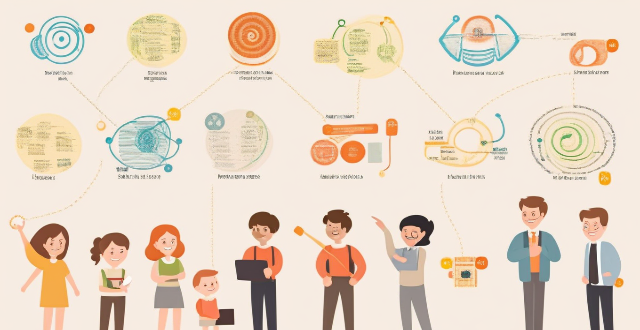Climate Education

How can we incorporate climate education into the school curriculum ?
Incorporating climate education into the school curriculum is crucial for preparing future generations to face the challenges posed by climate change. The strategies for integrating climate education include a cross-curricular approach, real-world applications, project-based learning, guest lectures and workshops, technology integration, critical thinking and problem solving, global perspectives, artistic expression, policy and advocacy, and continuous assessment. These approaches engage students across disciplines and prepare them for active participation in addressing one of the most pressing issues of our time.

How can education help combat climate change ?
Education is a powerful tool in the fight against climate change by fostering awareness, promoting sustainable practices, stimulating innovation, and shaping policy. It empowers individuals to make informed decisions and advocate for environmental protection through comprehensive science education, applied learning experiences, interdisciplinary research, and civic engagement. By integrating sustainability into curricula and encouraging global perspectives, education prepares future generations to tackle the complex challenges of climate change effectively.

How can we improve climate education in schools ?
Climate education is a crucial aspect of modern education that helps students understand the complexities of our planet's climate system and the impact of human activities on it. Improving climate education in schools requires integrating climate science into various subjects, training educators, engaging students through real-world experiences, and utilizing technology and multimedia tools. By implementing these strategies, we can prepare future generations to tackle the challenges posed by climate change and create a more sustainable future for all.

How can we improve climate change education in higher education institutions ?
Climate change is a pressing global issue that requires immediate attention and action. Higher education institutions play a crucial role in shaping the future leaders and decision-makers who will tackle this challenge. Therefore, it is essential to improve climate change education in these institutions to ensure that students are well-equipped with the knowledge, skills, and attitudes necessary to address this complex issue. Key strategies for improving climate change education include integrating climate change into curriculum, promoting research and innovation, engaging students in real-world projects, fostering sustainability on campus, enhancing faculty training and development, and encouraging student leadership and advocacy. By implementing these strategies, higher education institutions can play a vital role in addressing climate change and creating a more sustainable future.

What is the impact of climate change on children's access to education ?
Climate change affects children's access to education through extreme weather events, health impacts, food security issues, and displacement and migration. These challenges make it difficult for children to attend school or continue their studies. It is crucial to take action now to mitigate the effects of climate change and protect the future of education.

What is the role of education in addressing climate change ?
Education is pivotal in addressing climate change by empowering individuals with knowledge, skills, and attitudes necessary to understand and combat the issue. It cultivates a culture of sustainability and resilience, preparing future generations to face the challenges posed by a changing climate. Education raises awareness about the science behind climate change, promotes environmental literacy, and fosters a fundamental understanding of the complex interactions between human activities and the environment. By integrating climate change into school curricula and higher education programs, students learn about the importance of biodiversity, renewable energy sources, and sustainable practices, equipping them with the tools to make informed decisions and adopt eco-friendly behaviors. Education encourages critical thinking and problem-solving skills, which are essential for finding innovative solutions to mitigate and adapt to climate change. Students are encouraged to engage in projects and research that promote sustainability and environmental conservation. Education can inspire a sense of responsibility towards the environment, encouraging individuals to take active roles in protecting it. This can lead to community-based initiatives, such as tree planting, waste reduction campaigns, and advocacy for environmental policies. Educated citizens are better equipped to participate in democratic processes, ensuring that climate change is addressed through effective policies and regulations. They can hold governments and corporations accountable for their environmental impacts and push for systemic changes. Education is vital for developing a green economy by creating jobs in renewable energy, sustainable agriculture, and other environmental sectors. It prepares the workforce for industries of the future, where sustainability is a core value. Education promotes cross-cultural understanding and cooperation, which is essential for addressing a global issue like climate change. International exchange programs and collaborations can share best practices and technologies across borders. Education is crucial for building the capacity of communities disproportionately affected by climate change, enabling them to adapt and thrive despite adverse conditions. It ensures that everyone has access to information and resources needed to cope with climate-related challenges. In conclusion, education is a powerful tool in the fight against climate change, informing and empowering individuals to become agents of change.

How can education and awareness programs support climate adaptation ?
Education and awareness programs are crucial for climate adaptation, empowering individuals, communities, and policymakers with knowledge and skills to understand and respond to climate change impacts. These programs can raise public awareness, enhance decision-making capabilities, build resilience, promote sustainable practices, and facilitate behavioral change. Key actions for implementing effective education and awareness programs include curriculum integration, public campaigns, community workshops, and partnership initiatives.

What role do education and awareness play in promoting citizen action on climate change ?
Education and awareness are crucial for promoting citizen action on climate change. They help individuals understand the science, develop skills, foster critical thinking, raise consciousness, mobilize public support, and promote behavioral change. Strategies for enhancing education and awareness include integrating climate change into curricula, community workshops, media campaigns, and partnerships with NGOs and corporations. Investing in education and awareness is essential for creating a more resilient and equitable future.

How can education help in raising awareness about the climate emergency ?
Education is vital for raising awareness about climate change, empowering individuals with knowledge, and fostering a culture of sustainability and action. Integrating climate change education into curriculums and promoting interdisciplinary learning can influence perception through knowledge dissemination, skills development, values formation, and behavior change. Strategies for integrating climate change education include curriculum integration, interactive learning experiences, technology and digital tools, and global perspectives. By prioritizing climate change education, educators, policymakers, and community leaders play a crucial role in shaping a sustainable future.

How can we measure the effectiveness of climate education programs ?
Measuring the effectiveness of climate education programs is crucial for understanding their impact on participants and refining future approaches. Short-term outcomes include increased knowledge, shifted attitudes, and intentions to act, while long-term outcomes encompass behavioral changes, sustained engagement, and influence on others. Methods of evaluation include surveys, interviews, focus groups, and behavioral observations. By using a combination of quantitative and qualitative methods, we can gain a comprehensive understanding of the program's impact and ensure that climate education efforts are continually refined and improved for maximum efficacy.

What are the implications of climate change on the education and well-being of children worldwide ?
Climate change has significant impacts on the education and well-being of children worldwide. These impacts include disruption of education due to school closures and migration, health issues related to increased heatwaves and air quality problems, nutritional deficiencies from crop failures and food insecurity, psychological stress from natural disasters and anxiety about the future, loss of playgrounds and outdoor learning spaces, and socioeconomic impacts such as economic hardship and inequality in educational opportunities. Addressing these challenges requires a comprehensive approach that involves mitigating the effects of climate change and adapting educational systems to be more resilient.

How can schools incorporate climate change education into their curriculum ?
Incorporating climate change education into school curriculums is crucial for preparing students to address the global issue of climate change. Schools can integrate climate change concepts into existing subjects like science, social studies, literature, and mathematics. Science and geography classes can teach about the causes and effects of climate change, while social studies and history courses can provide a historical perspective on environmental challenges and analyze current policies. Literature and language arts classes can study works that address environmental themes, and mathematics and technology courses can explore data analysis and innovative solutions to combat climate change. Interdisciplinary approaches such as project-based learning and service learning can further enhance climate change education. Research projects and community outreach initiatives allow students to apply their knowledge in real-world settings, promoting interdisciplinary thinking and fostering a sense of personal responsibility for contributing to positive change. Overall, incorporating climate change education into school curriculums is essential for empowering students with the knowledge and skills needed to make informed decisions and take action towards a more sustainable future.

How can we address the lack of climate education in developing countries ?
Addressing the lack of climate education in developing countries requires a multi-faceted approach that considers local contexts, cultural values, and educational infrastructures. Strategies include prioritizing climate education at the policy level, enhancing access to educational resources, training and supporting educators, community engagement and empowerment, building sustainable infrastructure, research and development, and international cooperation and exchange. By implementing these strategies, developing countries can work towards bridging the gap in climate education and ensure that future generations are equipped with the knowledge to confront the challenges of our changing climate.

How can universities contribute to climate change research and education ?
Universities contribute to climate change research and education through various initiatives. They establish research centers for interdisciplinary collaboration on climate modeling, renewable energy, and sustainability science. Funding from multiple sources supports these ambitious projects. In education, universities integrate climate change into the curriculum, engage in public outreach, and encourage student involvement. Sustainable campus operations demonstrate commitment and provide real-world examples. Universities also influence policy and engage in international collaborations to address the global nature of climate change. Overall, universities play a crucial role in advancing understanding and solutions for climate change.

What are the long-term effects of not having a comprehensive climate education program ?
The text discusses the various long-term effects of not implementing a comprehensive climate education program. It highlights the lack of awareness and understanding about climate change, the proliferation of misinformation and misconceptions, limited adaptation and mitigation strategies, inadequate response to climate events, lost opportunities for green jobs, increased costs of climate change impacts, polarized public opinion, and ineffective policy decisions. The text emphasizes the importance of investing in comprehensive climate education programs to address these issues effectively.

How can we ensure that climate education is accessible to all students, regardless of their background or socioeconomic status ?
Climate education is crucial in modern times due to increasing concerns about global warming and climate change. However, not all students have equal access to this education due to factors such as socioeconomic status, location, and background. To ensure that climate education is accessible to all students, schools can incorporate it into the curriculum, provide resources and materials, offer extracurricular activities, partner with community organizations, provide financial support for low-income students, train teachers and educators, encourage student participation and feedback, promote interdisciplinary approaches, address language barriers, and collaborate with parents and guardians. By implementing these measures, we can create an inclusive learning environment where every student has equal opportunities to learn about climate change and take action towards a sustainable future.

How can education and awareness-raising help promote both climate action and the SDGs ?
Education and awareness play a crucial role in promoting climate action and achieving the Sustainable Development Goals (SDGs). By providing individuals with knowledge and understanding of complex environmental issues, we can empower them to make informed decisions and take action towards a more sustainable future. Educational programs can promote environmental literacy, encourage active engagement, and build capacity for innovation that supports both climate action and the achievement of the SDGs. Strategies for promoting climate action and the SDGs through education and awareness include integrating sustainability into curricula, promoting interdisciplinary collaboration, partnering with community organizations, and utilizing technology and social media.

How can we make climate education more engaging for students ?
To make climate education more engaging for students, educatorTo make climate education more engaging for students, educator methods, technology and multimedia integrate the subject across the curriculum, foster curiosity, and connect with local issues and opportunities.

How can we ensure that climate education is accessible to all students, regardless of their socioeconomic background ?
Education about climate change is crucial for the future of our planet, and it's essential that this knowledge is accessible to all students, regardless of their socioeconomic background. Here are some ways we can ensure that: 1. Public Funding for Education: By increasing public funding for education, we can provide more resources to schools that serve low-income communities. This includes providing textbooks, technology, and other materials necessary for teaching about climate change. 2. Digital Learning Platforms: Digital learning platforms can be used to deliver climate education to students who may not have access to traditional classroom settings. These platforms can provide interactive lessons, videos, and simulations that can help students understand complex concepts related to climate change. 3. Community Outreach Programs: Community outreach programs can help bridge the gap between schools and underserved communities. These programs can offer workshops, field trips, and other activities that focus on climate change education. 4. Inclusive Curriculum Design: Curriculum design should be inclusive of all students, regardless of their socioeconomic background. This means incorporating diverse perspectives and experiences into the curriculum, as well as addressing issues related to social justice and equity. 5. Teacher Training and Support: Teachers play a critical role in delivering climate change education to students. Providing training and support to teachers can help them develop effective strategies for teaching about climate change, especially in diverse classroom settings.

How can we ensure that climate education and awareness efforts are accessible and relevant to diverse communities ?
The text discusses strategies for making climate education more inclusive and effective, including using language appropriately, considering cultural differences, addressing socioeconomic status, and involving youth. It emphasizes the importance of tailoring messages and materials to be culturally sensitive and relevant to each community, providing free or low-cost resources, and partnering with local organizations to reach diverse communities directly. The text concludes that by taking these factors into account, we can create more inclusive and effective climate education programs that inspire action across all sectors of society.

How can education institutions foster climate leadership among students ?
Education institutions can foster climate leadership among students through curriculum integration, extracurricular activities, infrastructure improvements, collaboration and partnerships, and policy and leadership support. By adopting these strategies, they can contribute to global efforts in mitigating climate change.

How can we encourage parents to support climate education at home ?
Climate education is crucial for children's understanding of environmental conservation. Here are ways to encourage parents to support it at home: 1. Provide information and resources like books, websites, and documentaries. 2. Suggest family activities such as nature walks and recycling projects. 3. Model environmentally friendly behaviors like reducing waste and conserving energy. 4. Encourage open discussions about climate change and its impact. 5. Participate in community events that promote environmental awareness and action.

What role do teachers play in promoting climate education ?
Teachers play a pivotal role in climate education by enhancing awareness, fostering critical thinking, encouraging ethical responsibility, and promoting active engagement among students. They achieve this through various methods including providing scientifically accurate information, facilitating understanding, stimulating inquiry, analyzing data, integrating sustainability principles, and designing practical projects. Furthermore, teachers prepare students for future challenges by highlighting climate-related careers and fostering lifelong learning about environmental issues. Overall, educators are instrumental in guiding students towards becoming informed citizens capable of addressing the complexities of climate change and contributing to a sustainable world.

How can young people balance their education and involvement in climate action ?
Balancing education and involvement in climate action is crucial for young people. Effective strategies include time management, goal setting, and seeking support from peers and mentors. By prioritizing tasks, breaking down goals into smaller steps, and celebrating milestones, young people can achieve a balance between their education and involvement in climate action initiatives. Joining a community of like-minded individuals, finding a mentor, and collaborating with peers can also provide valuable support and opportunities for growth. With these strategies, young people can make a positive impact on the environment while achieving their educational goals.

How can we protect children from the adverse effects of climate change ?
Climate change poses significant threats to children's well-being, affecting their health, education, nutrition, and mental health. To protect them, we can focus on education and awareness, health protection, nutrition and food security, mental health support, and infrastructure and urban planning. This includes integrating climate change education into school curriculums, engaging communities in workshops, ensuring safe housing and air quality, improving healthcare accessibility and vaccination programs, establishing school gardens and supporting local farmers, providing counseling services and community support networks, and developing resilient infrastructure and safe public spaces.

How do climate adaptation policies integrate water resource management ?
Climate adaptation policies play a crucial role in water resource management by assessing climate change impacts, developing adaptation strategies, implementing and monitoring measures, securing finance and investment, and promoting education and awareness. These efforts aim to reduce vulnerabilities of human and natural systems to climate change, focusing on risks such as temperature changes, precipitation variability, and extreme events. Adaptation strategies include water conservation, infrastructure adaptations, legal and institutional frameworks, pilot projects, monitoring and evaluation, capital investment, operational costs, public education campaigns, and capacity building. This integration ensures water security for future generations by addressing the complex interactions between climate change and water resources.

What resources are available for teachers who want to incorporate climate education into their lessons ?
There are many resources available to help teachers incorporate climate education into their lessons, including online courses and training programs, curriculum materials and lesson plans, books and articles, videos and multimedia resources, and professional development opportunities. These resources provide teachers with the knowledge and skills needed to effectively teach about climate change, as well as engaging and informative materials for students. By utilizing these resources, teachers can help students understand the importance of climate change and its impacts on society and the environment.

What role do schools play in educating children about their rights in the context of climate action ?
Schools play a crucial role in educating children about their rights, especially regarding climate action. They are responsible for providing academic knowledge and shaping the values, attitudes, and behaviors of future generations. In the face of the climate crisis, schools have the opportunity to empower students by teaching them about their rights and responsibilities related to environmental protection. The importance of climate education includes raising awareness and understanding, promoting rights-based learning, fostering responsibility and accountability, and developing critical thinking and problem-solving skills. Integrating climate education into the school curriculum involves a cross-curricular approach, project-based learning, extracurricular activities, community engagement, and implementing green school initiatives and supportive policies. By doing so, schools can empower students to become informed, responsible citizens who are equipped to tackle the climate crisis head-on.

How does climate change affect education ?
Climate change impacts education through extreme weather events, health issues, food insecurity, economic challenges, social changes, and environmental degradation. These effects necessitate collaboration between educators and policymakers to develop resilient strategies for adapting to climate change.

What are some successful examples of climate change education programs in schools ?
Climate change education is becoming an increasingly important aspect of the curriculum in schools around the world. Here are some successful examples of climate change education programs: 1. The Climate Change, Energy and Sustainability (CCES) program is a comprehensive educational initiative that aims to teach students about climate change, energy production, and sustainability. Students who participate in the CCES program have shown significant improvements in their understanding of climate change and its impacts on society and the environment. They also demonstrate increased awareness of sustainable practices and energy conservation. 2. The Cool School Challenge is a global competition that encourages schools to reduce their carbon footprint by implementing energy-saving measures and promoting sustainable behaviors among students and staff. Schools participating in the Cool School Challenge report reductions in energy consumption, waste generation, and greenhouse gas emissions. Additionally, students develop a sense of ownership and pride in their efforts to combat climate change. 3. The National Oceanic and Atmospheric Administration's (NOAA) Climate Stewards Program is designed for high school students interested in pursuing careers related to climate science or environmental policy. The program provides opportunities for hands-on research experiences, mentorship from climate experts, and participation in scientific conferences. Students participating in the Climate Stewards Program gain valuable insights into the complexities of climate science and develop skills that are highly sought after by universities and employers in related fields. 4. The Global Classroom Initiative is a collaborative project between schools worldwide that focuses on sharing knowledge and resources related to climate change and sustainability. Through video conferencing, online forums, and joint projects, students from different countries learn from each other and work together to address global challenges. Students involved in the Global Classroom Initiative develop cross-cultural communication skills and a deeper understanding of the interconnectedness of climate issues across borders. They also become more engaged with global citizenship and feel empowered to make positive changes in their communities. 5. The Eco-Schools Programme is an international program that encourages schools to implement environmentally friendly practices such as reducing waste, conserving water, and using renewable energy sources. Schools earn eco-flags for achieving certain benchmarks and can participate in regional and national competitions. Schools participating in the Eco-Schools Programme report significant reductions in their carbon footprint and improved overall environmental performance. Students also develop critical thinking skills and a sense of responsibility towards protecting the planet.